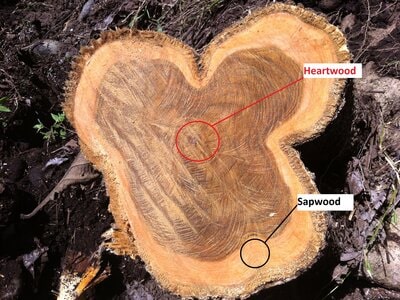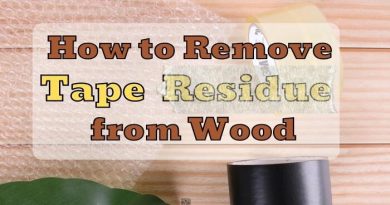How to Identify Real Teak Wood [In 6 Easy Steps]
For several years, teak is one of the most used materials for garden furniture. But, to benefit from it, you still have to know how to identify real teak wood and how to distinguish it from fake teak.
In the face of the abundant supply and the price differences, it is not always clear whether the garden furniture you are looking for is actually made of real teak.
What does real teak look like?

Teak is an exotic wood much appreciated for its elegance and durability .
The heartwood is dark gold-yellow in color, turning dark brown with exposure to light; the sapwood is pale yellowish, well differentiated. Teak wood is fine and hard, a quality that is highly appreciated for various uses, it is a wood that contains silica; easy to work, dry and preserve, its natural durability is good and it has dimensional stability
And it does not date from today! Already in the 7th century, it embellished the most beautiful homes in Asia. The most common species of teak are:
- Tectona grandis
- Indochinese teak.
The teak from the island of Java (Indonesia), with a magnificent dark brown color, is one of the most beautiful variants of teak. This is also why we have chosen to have all our furniture manufactured by local craftsmen on the island of Java.
The wood comes from forests controlled and protected by the Indonesian government. Considering where the wood comes from is one of the first things to do when choosing your teak garden furniture. Today it can come from India, Africa or Central America.
How to Identify Real Teak Wood?
The color, hardness and lifespan of teak can vary from wood to wood as there are significant differences in quality. In order not to be mistaken, know that the wood is classified in different grades .
These will give you information on the appearance, color and resistance of the teak wood:
- Class A: the best class for teak. The wood has a uniform color and is distinguished by its robustness. It usually comes from a tree over 30 years old because the older the tree, the more robust the wood;
- Class B: if the class B teak also has a good appearance, although more homogeneous, it may have dark spots and more knots;
- Class C: finally, a classified C teak is much less resistant because it comes from young trees. Teak naturally contains an abundance of oils and oleoresin which allows it to be more resistant. If it is cut young, it contains less and therefore has a shorter lifespan.
Today, teak extraction from natural forests is prohibited or severely restricted in all countries except Myanmar.
Here is how to identify teak wood:
Color
Teak wood can be recognized by the whitish sapwood and yellowish or bronze heartwood. The grain is generally straight, although on rare occasions it may present wavy grain that is common from the one from from India.
The color of teak wood varies depending on the species of the tree and where it comes from. The tone ranges from dark golden brown to yellowish white. Knowing what type of teak you are looking for is important when examining the color.
- The outer layer of the tree is called sapwood and is yellowish-white in color. The sapwood of the teak has a higher moisture content and is therefore weaker than heartwood.
- The core of the tree is called heartwood and ranges from golden brown to dark brown. The heartwood is harder, stronger, more expensive, and generally more valued than sapwood.
Usually, teak wood dries without cracking or throwing. However, with changing climatic conditions and long transport routes, minimal warping can be seen. That is why this process is usually accelerated technically in order to ensure a consistently high quality during later use.
Grain
Grain is an important factor to identify teak wood. Generally, the grain of real teak wood is straight.
They will appear as straight grains or lines of a darker color than the rest of the wood. If the grain does not appear straight or at least mostly straight, you will need to ask a few questions.
The teak tree is dependent on a tropical climate; only under these conditions can it grow and thrive. The teak becomes hard and stable over time, with a naturally beautiful grain.
The grain is coarse with the presence of variable levels of silica.
Teak has straight grain. Trees grow at different rates during different seasons. This tree growth pattern is reflected in the growth rings, which become lighter and darker as the wood is cut.
On a cut piece of wood, this is known as grain. Teak can also be made clear by touch. If you rub your hands on the wood, it won’t shatter. It’s very smooth to the touch.
Weight
Weight is another way to identify teak wood. Real teak wood will be very dense and fairly heavy. Collect the wood and put it to the test. It should be heavier than chipboard. If it feels light and porous in your hands, it’s probably not teak wood.
Oil content
The forth way to identify teak wood it is by it’s oil content. It has an oily touch and freshly cut it has a strong smell of old leather that disappears to a great extent when drying. In addition, it is one of the few woods that produces its own oil, which prevents it from drying out.
One of the distinguishable features of teak is its exceptionally high oil content. With increasing age, this oil content can be up to five percent of the tree’s own weight.
The tree oil is an important factor for the special quality characteristics of tropical hardwood. However, the tree will only develop a high oil content over the course of many years.
If it is felled too early, the percentage of oil will be very low and the wood will be of inferior quality. In addition, the color-intensive and high-quality center of the wood trunk also only develops later. Very young teak is light, pale and extremely soft; it can be pressed in with a fingernail.
Robust & resilient
Due to its excellent properties, teak wood is coveted throughout the world (it is characterized by its strength, durability, dimensional stability and its beauty).
Within a few years after the tree is established in the field, it is virtually indestructible. The properties of teak make it highly resistant to fire, pests, diseases and other problems typical of other woods.
Teak is resistant to warping, cracking, and deterioration and is best used in fine furniture, doors, window frames, flooring, and general construction.
Thanks to its robust features, teak is a robust material for indoor and outdoor use. The natural material is now one of the most frequently used types of wood around the world.
The tropical hardwood has a high degree of dimensional stability, so it hardly shrinks or warps. For this reason it is an ideal starting product for use in the garden and on the terrace, especially for frame constructions including windows and doors.
Furthermore, the wood scores with a very long service life after processing, which can be more than 25 years with good care.
Teak is especially used in outdoor furniture and in more humid areas due to its high resistance to humidity.
Due to its high resistance of Teak to chemical agents, it is ideal as a counter top for laboratories and kitchens, as well as washing towers, tubs, tanks, vats, pipes, and smoke ducts for chemical plants.
What is Plywood? Why Is It So Special?
Patina
Over time, the surface of the teak wood often develops a patina, which is typical for the aging process in this type of wood. Over the years, the honey-brown and previously very conspicuous wood discolors, it becomes more colorless and inconspicuous. However, this only happens if the surfaces outside are left untreated.
Sometimes this process occurs even after a few weeks, when it has rained a lot and in between strong sunlight has arisen. If you don’t want to have a patina on the teak and want to keep the natural color, you should take care of the wood accordingly.
- Strong weather conditions lead to a silver-gray color
- Patina sometimes has dark gray features
- In a very humid climate even slightly greenish
- Oil or wax regularly for prevention
- Remove coarse soiling with soapy water
- Carefully sand off stubborn stains
- In extreme cases, complete sanding is possible
Over time, untreated teak takes on a silver-gray patina. If you love that, then it is enough to clean the furniture with a brush and soapy water once or twice a year. Then rinse with clear water, done! You can safely sand off scratches, paint residues or stains with sandpaper.
Fragrance
The smell of teak wood: the natural substances contained in the teak give off a characteristic odor because of the oil presence which resemble leather fragrance ! If the wood does not emit any odor, it is probably not teak .
Teak is a hard and heavy wood , with a streaked brown color. It is extraordinary to work with. Freshly cut it has a strange waxy texture and a leather-like smell. It cuts well, and like oak, darkens with exposure to light.
Characteristics of Teak Wood
| Proprieties of Teak Wood |
| Color : The sapwood is light yellow and the heartwood has brown and golden tones. It is a wood that ages really well, since its coloring improves. |
| Fiber : Generally straight. Sometimes wavy. |
| Grain : Coarse. |
| Density : It has an approximate density of 690 Kg / m3. Semi-heavy wood. |
| Hardness : 4.2 according to the Monnin test. It is a semi-hard wood. |
| High durability . Very good resistance to humidity and attack by fungi and insects. It is even possible to leave it in the open without treatment thanks to its natural oils. It is difficult to find woods that offer similar durability being so light, they are usually much denser. In this sense, there are important differences between cultivated teak and that which grows naturally, the latter being the one with the best durability. |
| Dimensional Stability : It is a dimensionally stable wood. Dimensional stability coefficient: 0.34%. Teak wood is little edgy. |
| Mechanical Properties : Compressive strength: 570 kg / cm 2 Static bending strength: 1,000 kg / cm 2 Modulus of elasticity: 140,000 kg / cm 2 |
| Impregnation : Sapwood slightly impregnable, heartwood not impregnable. |
| Workability : Sawn: No problems. It can accelerate tool wear due to its high silica content. Drying: Slow, practically without risk of deformation or cracks. Brushing: No problem. After being cut or brushed it has the smell of leather. Gluing: Some problems may be encountered due to its resins or natural oils. In these cases it will be necessary to clean the surface. Nailing and screwing: Pre-drilling should be no problem. Finish: None beyond the presence of resins or oils typical of wood. |
Teak wood is oily to the touch. It is due to its natural oil, which has interesting characteristics.
What is Wood Composite? Why Is The Best Material?
What Colour is teak wood?
Teak wood is typically deep golden brown in color, but has a wide range ranging from reddish to very pale tones. It also admits treatments or paints to change its color without losing its appearance.
It is one of the strongest, most durable and wear-resistant woods in existence, but due to the dull appearance and weight it has been taken into consideration in the West only recently.
In the restoration the Teak is not easy to use, because, like the rosewood it is difficult to glue and impossible to whiten.
Conclusion
Go through identifiable factors such as color, grain, smell, and weight. That way you can clearly know how to identify real teak wood. Real teak wood should have all the characteristic mentioned above.
Why does teak turn gray?
In bad weather conditions, teak forms a natural protective layer called a “patina”.
This has nothing to do with the deterioration of the furniture , but is a natural weathering process.
In which areas can teak be processed?
Since the wood from the teak tree is extremely weatherproof and resistant to moisture, it can also be used in wet rooms such as the bathroom and kitchen without any problems.
It can also be used outdoors in the form of floor coverings and patio roofs.




